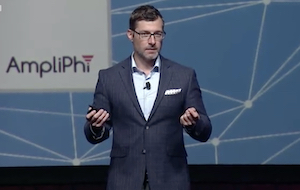 Developing a “digital doppelganger” that’s working for you 24/7 to establish an online presence and develop name recognition can be the make-or-break difference in closing a deal, advises retirement industry digital guru Spencer Smith.
Developing a “digital doppelganger” that’s working for you 24/7 to establish an online presence and develop name recognition can be the make-or-break difference in closing a deal, advises retirement industry digital guru Spencer Smith.
In a Sept. 14 keynote address at the 2021 NAPA 401(k) Summit, Smith shared insights on how 401(k) plan advisors can identify and amplify their digital presence to make sure they are top of mind for the prospects they are trying to reach. Smith is a founder of AmpliPhi, an early-stage investor/advisor to 20+ companies, and co-author of the bestseller, ROTOMA: the ROI of Social Media Top of Mind.
Smith outlined a series of steps in developing an online presence, including:
- developing a framework for Key Performance Indicators (KPIs) to measure what’s working and what’s not;
- developing an online role and deciding whether you want to be a host, guest, contributor or some combination thereof; and
- conducting what he called a “STEM” (smart, thoughtful, entertaining and motivating) test in determining which personality you would like to depict online.
In emphasizing the importance of these steps, Smith refers to ROTOMA—“return on top of mind awareness”—by which he means that “people are either thinking about you or they’re not, and if they’re not thinking about you, they can’t do business with you… the idea of showing up, and showing up constantly, is really important,” Smith advised.
KPI Framework
When it comes to KPIs, Smith suggests “bucketing” them to figure out what to measure and to determine over time what’s working—and therefore, what to manage. The first KPI framework is what he calls a “zero sum game,” meaning that if you’re not at the very top, you’re second or even lower.
“Any time we measure how high we’re ranking, and we do achieve that first spot, winning is fantastic, but then what happens?” Smith asked. And once you do achieve that first spot, you have a target on your back, he suggested, and you had better be prepared to act. One example he cites is search engine optimization (SEO) and how your practice is showing up in web searches.
A second style of KPI is what Smith calls collectibles. “You keep adding to your collections, and that’s something to do from a KPI standpoint to set you up for success over time by having a feel-good metric,” he explains. One example of a collectible is seeking to boost your social media followers and connections, say from 500 to 700.
A third style of KPI a high water mark, which he notes is important because you need to be prepared to peak. “It’s really important to understand that eventually we will retreat, so we want to set something up for success in that regard as well,” Smith said.
Host, Guest or Contributor?
Whether you have a LinkedIn profile or website, or you’re seeing people in person at networking events, the people involved can be broken down into three roles, Smith explains: the host, the guests and the contributors. “Whether you are hosting the party, whether you have the guests or whether you are an outside contributor, anything that you can do in this capacity will help raise your brand profile online,” Smith emphasizes. “You don’t need to be the star of the show, nor do you need to be. You can just add to the conversation very easily.”
Smith notes that this activity doesn’t have to pertain to your advisory business. He suggests looking outside the industry to share your best practices—as in a Facebook group, for example—about something that you are interested in, such as your hobbies. From there, he notes, you can develop relationships that may eventually turn into sales leads.
Smith also suggests trying to differentiate yourself beyond just compliance-approved boilerplate posts that anyone can create. “We need to differentiate you by way of what it is that you share that’s personal to you. That’s how we get people to understand who you truly are and that’s when they want to do business with you,” he explained.
STEM Test
As for the STEM test, Smith explains that it has three core components:
- what you share is fulfilling to you;
- what you share helps your audience feel the way you’d like them to feel; and
- what you share on the platform is appropriate for the content you’re sharing.
Why is it important that you share the things you care about and are fulfilling to you? Smith notes that if you don’t, eventually you won’t do those anymore, which will lead to an inconsistent, haphazard way of doing business. In contrast, if you share things that you care about and do it consistently over time, you start to build your brand, which leads to higher recognition within the communities you’d like to serve, he noted. Additionally, if people have a fear of missing out on the content you’re sharing, it helps them perceive you as a valuable source of information.
Call Confidence
Once you have a digital doppelganger that’s working around the clock, it helps boost your confidence. “When you reach out to people or see them in person, and they welcome what it is that you’re sharing, suddenly call confidence and sales enablement gets a lot easier,” Smith emphasizes. “If we just dial it up a little bit more, feel better about what it is that we’re doing, and have that digital version of us helping that along—that’s really what this can do for you: creating more confidence in your practice by knowing that you’re representing something that’s welcome online.”

